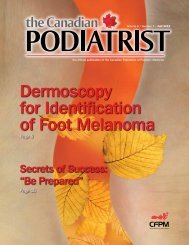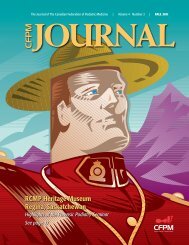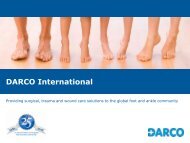Optimizing the Use of Cleat Shimming in Chronic Knee Pain ...
Optimizing the Use of Cleat Shimming in Chronic Knee Pain ...
Optimizing the Use of Cleat Shimming in Chronic Knee Pain ...
You also want an ePaper? Increase the reach of your titles
YUMPU automatically turns print PDFs into web optimized ePapers that Google loves.
<strong>Optimiz<strong>in</strong>g</strong> <strong>the</strong> <strong>Use</strong> <strong>of</strong> <strong>Cleat</strong><br />
<strong>Shimm<strong>in</strong>g</strong> <strong>in</strong> <strong>Chronic</strong> <strong>Knee</strong> Pa<strong>in</strong><br />
Management among Road<br />
Cyclists<br />
Presented by:<br />
Silvia Araujo, Arien Sirois, Emily Stock, D.Ch Candidates<br />
The Michener Institute, Toronto, ON
Background<br />
Ø Cycl<strong>in</strong>g has become a popular form <strong>of</strong><br />
recreation, competition, and commut<strong>in</strong>g<br />
(Callaghan, 2005)<br />
Ø Clarsen et al. (2010) cite anterior and lateral<br />
knee pa<strong>in</strong> as <strong>the</strong> most common overuse <strong>in</strong>juries<br />
to cause time lost from cycl<strong>in</strong>g, prompt<strong>in</strong>g <strong>the</strong><br />
need for identify<strong>in</strong>g <strong>in</strong>tr<strong>in</strong>sic and extr<strong>in</strong>sic risk<br />
factors that dictate appropriate <strong>in</strong>terventions<br />
(Fig. 1)
Cycl<strong>in</strong>g and <strong>Knee</strong> Pa<strong>in</strong><br />
Ø Due to <strong>the</strong> repetitive nature <strong>of</strong> cycl<strong>in</strong>g,<br />
overuse <strong>in</strong>juries are commonly reported<br />
among cyclists (Callaghan, 2005) with 36%<br />
(Fig. 1) <strong>of</strong> <strong>the</strong>se attributed to <strong>the</strong> knee<br />
(Clarsen et al, 2010)
Background<br />
Ø <strong>Chronic</strong> anterior knee pa<strong>in</strong> is<br />
most commonly caused by<br />
patell<strong>of</strong>emoral pa<strong>in</strong> syndrome<br />
(PFPS) while chronic lateral<br />
knee pa<strong>in</strong> is largely <strong>in</strong>dicative<br />
<strong>of</strong> iliotibial band friction<br />
syndrome (ITBS) (Dettori &<br />
Norvell, 2006)
Cycl<strong>in</strong>g and <strong>Knee</strong> Pa<strong>in</strong><br />
Ø Asplund et al. (2004) reported<br />
that anatomic variations <strong>in</strong> lower<br />
limb alignment, such as limb<br />
length discrepancy, genu varum,<br />
and excessive STJ pronation<br />
(Farrell et al., 2003; Dettori et<br />
al, 2006), <strong>of</strong>ten lead to <strong>the</strong> onset<br />
<strong>of</strong> overuse <strong>in</strong>jury, caus<strong>in</strong>g<br />
dysfunction and pa<strong>in</strong><br />
www.turbosquid.com
Management Approaches<br />
Ø Current approaches to manag<strong>in</strong>g knee pa<strong>in</strong> <strong>in</strong><br />
cyclists <strong>in</strong>clude: modifications to <strong>the</strong> bike,<br />
address<strong>in</strong>g tra<strong>in</strong><strong>in</strong>g errors, add<strong>in</strong>g removable<br />
<strong>in</strong>soles, and cleat shimm<strong>in</strong>g <strong>in</strong> order to alter<br />
foot position at <strong>the</strong> pedal <strong>in</strong>terface (Burke,<br />
2003)<br />
Ø Dettori et al. (2006) and Asplund et al. (2004)<br />
advocate that a proper bike fitt<strong>in</strong>g is essential<br />
for every rider, as <strong>in</strong>correct fit may <strong>in</strong>crease<br />
repetitive forces through <strong>the</strong> knee
Evidence for <strong>Shimm<strong>in</strong>g</strong>?<br />
Ø The addition <strong>of</strong> varus wedg<strong>in</strong>g or shimm<strong>in</strong>g to<br />
address <strong>in</strong>tr<strong>in</strong>sic factors (i.e., LLD or forefoot<br />
deformities) <strong>in</strong> order to treat overuse knee<br />
<strong>in</strong>juries <strong>in</strong> cycl<strong>in</strong>g is cited by Burke (2003),<br />
Sanner et al. (2000), and Asplund et al. (2004),<br />
but is <strong>of</strong>ten anecdotal and not evidence-based<br />
www.probikekit.com
Research Aim<br />
Ø The aim <strong>of</strong> this research is to <strong>of</strong>fer a cl<strong>in</strong>ical<br />
approach <strong>in</strong> implement<strong>in</strong>g cleat shimm<strong>in</strong>g to<br />
m<strong>in</strong>imize <strong>the</strong> impact <strong>of</strong> <strong>in</strong>tr<strong>in</strong>sic forefoot<br />
deformities on <strong>the</strong> knee<br />
Ø Primary objective: To determ<strong>in</strong>e whe<strong>the</strong>r cleat<br />
shimm<strong>in</strong>g can effectively reduce chronic knee pa<strong>in</strong><br />
<strong>in</strong> cyclists<br />
Ø Secondary objectives: To determ<strong>in</strong>e if lateral or<br />
medial knee pa<strong>in</strong> will benefit more from <strong>the</strong> use <strong>of</strong><br />
cleat shimm<strong>in</strong>g and correlate degree <strong>of</strong> deformity<br />
to degree <strong>of</strong> pa<strong>in</strong> relief
Hypo<strong>the</strong>sis:<br />
Custom-fitted cleat shims will lead to a<br />
reduction <strong>in</strong> reported chronic knee pa<strong>in</strong><br />
cycl<strong>in</strong>gtips.com.au
Proposed Methodology<br />
Ø Target population:<br />
healthy road cyclists,<br />
age 18-34, recruited<br />
from local<br />
community<br />
Ø Subject eligibility<br />
determ<strong>in</strong>ed by<br />
recruitment<br />
questionnaire and<br />
comprehensive<br />
biomechanical<br />
assessment<br />
janhe<strong>in</strong>e.wordpress.com
Proposed Methodology<br />
Pre-assessment Period:
Proposed Methodology
Proposed Methodology
Outcome measures<br />
Ø Determ<strong>in</strong>ed at weeks 4, 8, and 12<br />
Ø Include:<br />
Forefoot deformity values<br />
Pa<strong>in</strong> <strong>in</strong>tensity<br />
Degree <strong>of</strong> pa<strong>in</strong> relief with <strong>in</strong>clusion <strong>of</strong> 100 po<strong>in</strong>t<br />
VAS and VRS<br />
Ø Secondary measures:<br />
Subgroup analysis <strong>of</strong> lateral and medial knee pa<strong>in</strong><br />
Degree <strong>of</strong> pa<strong>in</strong> relief achieved <strong>in</strong> each subgroup
Statistical Analysis<br />
Ø A visual analog scale (VAS) and verbal<br />
rat<strong>in</strong>g scale (VRS) will be used to assess<br />
pa<strong>in</strong> <strong>in</strong>tensity (Fig. 3) with <strong>the</strong> objective<br />
aimed at determ<strong>in</strong><strong>in</strong>g <strong>the</strong> size <strong>of</strong> <strong>the</strong> VAS<br />
and VRS decrease, <strong>in</strong>dicat<strong>in</strong>g cl<strong>in</strong>ically<br />
mean<strong>in</strong>gful pa<strong>in</strong> relief
appropriate score
Statistical Analysis<br />
Ø Descriptive statistics will be computed as means ± SDs<br />
for quantitative variables and percentages for<br />
qualitative variables<br />
Ø A paired, one-tailed T test will assess treatment<br />
effectiveness from basel<strong>in</strong>e on study outcomes<br />
Ø L<strong>in</strong>ear correlation coefficients will be used to assess<br />
correlations pa<strong>in</strong> relief among lateral and medial pa<strong>in</strong><br />
Ø Means between groups at weeks 0 (basel<strong>in</strong>e) and 12<br />
(endpo<strong>in</strong>t) will be compared us<strong>in</strong>g analysis <strong>of</strong> variance<br />
(ANOVA)
Future Directions<br />
1. If cleat shimm<strong>in</strong>g effectively<br />
reduces chronic knee pa<strong>in</strong> <strong>in</strong> <strong>the</strong><br />
participants, this <strong>in</strong>tervention can<br />
be <strong>in</strong>corporated <strong>in</strong>to a standard,<br />
evidence-based treatment protocol<br />
for this target population
Future Directions<br />
2. Fur<strong>the</strong>r research <strong>in</strong>corporat<strong>in</strong>g<br />
larger sample sizes, and a randomized<br />
controlled approach will streng<strong>the</strong>n<br />
<strong>the</strong> efficacy <strong>of</strong> <strong>the</strong> f<strong>in</strong>d<strong>in</strong>gs and<br />
elim<strong>in</strong>ate <strong>the</strong> current anecdotal<br />
approach used <strong>in</strong> cleat shimm<strong>in</strong>g
Future Directions<br />
3. This research can <strong>of</strong>fer <strong>in</strong>sight <strong>in</strong>to<br />
<strong>the</strong> optimal degree <strong>of</strong> wedg<strong>in</strong>g,<br />
<strong>the</strong>reby promot<strong>in</strong>g its cl<strong>in</strong>ical use and<br />
applicability <strong>in</strong> <strong>the</strong> podiatric sett<strong>in</strong>g<br />
for overuse knee pa<strong>in</strong> <strong>in</strong> cyclists
Contacts<br />
Silvia Araujo, HBSc, D.Ch Candidate,<br />
saraujo423@michener.ca<br />
Arien Sirois, HBSc, D.Ch Candidate,<br />
asirois479@michener.ca<br />
Emily Stock, HBSc, D.Ch Candidate,<br />
estock402@michener.ca
References<br />
Asplund, C., & St Pierre, P. (2004). <strong>Knee</strong> pa<strong>in</strong> and bicycl<strong>in</strong>g. The<br />
Physician and Sports Medic<strong>in</strong>e, 32(4), 1-12.<br />
Burke, E. (2003). High Tech Cycl<strong>in</strong>g.Ill<strong>in</strong>ois: Human K<strong>in</strong>etics<br />
Publishers.<br />
Callaghan, M. (2005). Lower body problems and <strong>in</strong>jury <strong>in</strong> cycl<strong>in</strong>g.<br />
Journal <strong>of</strong> Bodywork and Movement Therapies 9(3), 226-236.<br />
Clarsen, B., Krosshaug, T., & Bahr, R. (2010). Overuse <strong>in</strong>juries <strong>in</strong><br />
pr<strong>of</strong>essional road cyclists. The American journal <strong>of</strong> sports<br />
medic<strong>in</strong>e, 38(12), 2494-2501.<br />
Dettori,N.J., & Norvell, D.C. (2006). Non-traumatic bicycle<br />
<strong>in</strong>juries. Sports Medic<strong>in</strong>e, 36(1),7-18.<br />
Farrell, K.C., Reis<strong>in</strong>ger, K.D., & Tillman, M.D. (2003). Force and<br />
repetition <strong>in</strong> cycl<strong>in</strong>g: possible implications for iliotibial band<br />
friction syndrome. The <strong>Knee</strong>, 10(1), 103- 109.
















